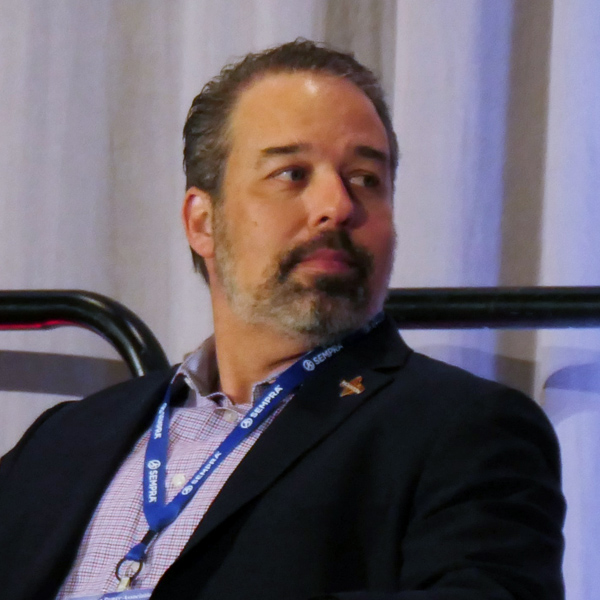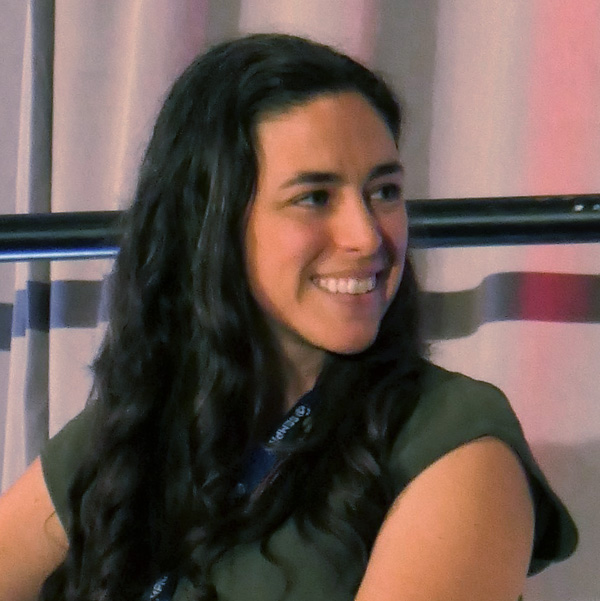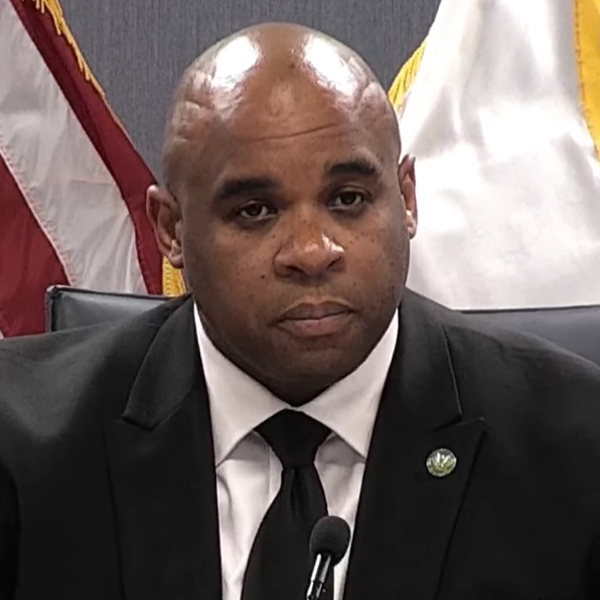HOUSTON — The Gulf Coast Power Association’s annual spring conference April 18-19 revolved around how Texas and its coastal region can become a hotspot for energy innovation.
 Anne Choate, ICF | © RTO Insider LLC
Anne Choate, ICF | © RTO Insider LLC
Anne Choate, executive vice president for energy, environment and infrastructure with consulting firm ICF, said the Gulf Coast can “further cement its goal as the innovative energy epicenter” of the world.
She said the region can impel clean energy infrastructure and long-term change for climate stabilization “in the same way we’ve been successful at repairing the ozone layer.” Choate said the industrial-heavy Gulf Coast has “powerful” potential in geothermal energy, carbon capture and green hydrogen technologies.
“It’s going to be a lot of work. We’re going to look like we’re gliding across the water, but we’re going to be paddling furiously underneath,” she said, saying it has the potential to make Silicon Valley look “quaint.”
“I think the Gulf region will be one of the most active regions, not just in the U.S., but globally, in carbon capture and sequestration,” predicted Frederik Majkut, senior vice president of carbon solutions at SLB New Energy.
 Brett Kerr, Calpine | © RTO Insider LLC
Brett Kerr, Calpine | © RTO Insider LLC
Brett Kerr, Calpine’s vice president of external affairs, said a healthy carbon capture industry will require a nexus of a young workforce, academics and financial capital.
“I truly believe that carbon capture can do for the Gulf Coast what tech did for the Bay Area,” he said.
Kerr said the Inflation Reduction Act’s passage means that carbon capture now makes financial sense.
“It’s always been good policy, but for the first time it really makes good business sense to pursue these projects,” he said.
Kerr said when power generation has a carbon capture facility backfit, it becomes no different from a wind or solar resource, save for an “on/off switch.” He said firm delivery will make retrofitted gas plants attractive to buyers.
Mark O’Donnell, Occidental’s assistant vice president of power, said decarbonizing the region’s natural gas plants will undoubtedly take carbon capture and a conversion to green hydrogen. He warned that at ambient temperatures, it takes three times the amount of hydrogen to produce the same amount of energy generated by natural gas.
“It’s not like you can’t overcome hurdles, but carbon capture, you’ve seen it and it’s proven,” O’Donnell said.
 Molly Bales, Form Energy | © RTO Insider LLC
Molly Bales, Form Energy | © RTO Insider LLCForm Energy Senior Business Development Manager Molly Bales said long-duration storage can de-risk utilities’ increasingly renewable generation portfolios.
Bales said her company is pioneering a rechargeable iron-air battery capable of storing power for a little more than four days at costs on par with legacy power plants. She said the batteries cost about one-tenth of lithium-ion battery facilities. The iron-air batteries “breathe” in oxygen from the air and convert iron metal to rust when discharging; the process is reversed when charging, with an electrical current converting the rust back to iron while the battery expels oxygen.
Bales said Form Energy realized that the grid needs multiday storage to firm up renewables and navigate mounting multiday weather events.
“This is an opportunity to build a whole new ecosystem,” Bales said. Form is planning to build its first battery factory in Weirton, West Virginia, a former steel town.
Bales said Form could be eyeing Texas for such a factory as soon as 2025. “We’re really excited about what’s happening in the next few years,” she said.
Inflation, Interest Curbing New Assets?
Julien Dumoulin-Smith, head of U.S. power utilities and clean energy research at Bank of America Securities, said “rampant” inflation and increasing interest rates are complicating the outlook for new asset construction.
“It’s not over,” he said of stubborn inflation. “You heard it here first.”
Dumoulin-Smith, a frequent questioner during utility earnings conference calls, said investments in carbon capture and sequestration “should be taken seriously” while green hydrogen is “similarly quite real.”
“This stuff ain’t cheap, but $85 per ton does wonders on the cost,” he said, referring to the newly enacted tax credit for carbon capture and storage.
However, Dumoulin-Smith said capacity prices and resource adequacy’s costs “have gone from zero to 100” seemingly overnight.
“I think we’re heading materially higher,” he predicted.
Dumoulin-Smith said that he expects Texas, Oklahoma and Arkansas to be most affected by generation retirements as the Environmental Protection Agency ratchets up regulations.
“We see a litany of new EPA rules ahead that could impact the generation stack again,” he said. EPA’s proposed crackdown on coal ash through effluent-limitation guidelines stands to move the needle on retirements, Dumoulin-Smith said.
He said 2023 will be a “catch up” year for solar panel supply as it recovers from last year’s trade issues. He said interconnection queue wait times also remain a problem.
“Bottom line is, you need to be very skeptical about when these projects can get done,” Dumoulin-Smith said, stressing that companies must consider how much time and money it will take to get grid treatment versus situating resources on the distribution system.
Advances in Tx Capacity
LineVision CEO Hudson Gilmer said there is a “mismatch” between today’s grid needs and planned transmission that’s five-to 10 years away. He said even Texas, which typically gets lines built faster than the rest of country, lags on new transmission capacity.
Gilmer said LineVision uses non-contact sensors and analytics to employ dynamic line ratings that allow 30-40% more power to flow through lines. He said utilities don’t always have to use “disaster plan” line ratings.
Gilmer said bottlenecks in interconnection queues have led utilities to his company.
“While no one wants to be the first to deploy a new technology, when they see their peers adopting it … there’s a tipping point,” Gilmer said. He added that dynamic line ratings have had a perception problem, with fears they would “cannibalize” the need for new transmission lines. Gilmer said contrary to that belief, the grid needs new firm capacity, even with the assistance of dynamic line ratings.
“It’s not an either-or situation. It’s an ‘and’ situation,” he said.
Stephen Conant, vice president at startup VEIR, said his company focuses on overhead superconductors that can increase line capacity without expanding rights-of-way or increasing transmission tower heights. He said superconductors are at an “exponential” adoption stage, though he admitted the costs aren’t yet competitive with normal conductors.
“There’s a huge need to build transmission capacity, but it’s difficult to site, as some as you have experienced,” he told attendees.
Conant urged the audience to remember that at one point, it was difficult to imagine the development of 18-MW offshore wind turbines when compared to the 1.5-MW turbines that were once the standard.
“In the time it takes you to build your next transmission line, you’re going to be giving me a very serious look,” he said.
Speakers with Differing Market Views
Texas Public Utility Commissioner Kathleen Jackson said she believes the state’s energy future will come down to a blend of “a lot of little things,” not a singular technological solution. She urged attendees to focus on the “data, science and economics” when standing up new technologies.
Jackson urged Texas utilities to focus on energy efficiency and investing in new assets. She said the state’s growing population demands forward planning and making the most out of existing generation.
“We have 1,200 people coming to Texas each day,” she said. “Nobody is bringing power with them.”
Carrie Bivens, ERCOT’s Independent Market Monitor, said growing load uncertainty and renewables dominance in Texas means that ERCOT is currently making avoidable out-of-market commitments. She said she expects the energy-only market to effectively send price signals that stir respondents and said she doesn’t foresee a “fundamental” market breakdown on the horizon.
Former FERC chair Joseph Kelliher expressed disappointment during a keynote address over how RTO executives lead wholesale markets today.
“When I was at FERC, we expected RTO leadership to be more FERC-like. And I know that sounds obnoxious,” he said, explaining that grid operators should make unpopular decisions at times.
“I think some RTOs have become more dedicated to stakeholder consensus than they do toward market integrity,” he said. “I think some RTOs have lost their way, and that’s their current approach.”
Kelliher said capacity markets, especially those in the Northeast, are disappointing and producing suppressed prices that won’t support new generation entry. He said grid operators might consider scrapping the markets altogether and focus instead on long-term contracts.
GCPA Debuts ‘Power Pitch’
The GCPA conference featured a new concept in Power Pitch, where early-stage energy technology companies competed for a $5,000 award styled after the “Shark Tank” television show. Bodhi, a software app that offers real-time, personalized updates on homeowners’ residential solar projects, took the award home to Austin.
The judging panel consisted of three professional energy investors, with the audience weighing in via an interactive survey. Criteria included the presentation’s quality, potential impact on the industry, and the business model’s potential success. Judges asked about the comparative costs of new technologies, risks of being copied, ease of manufacturing and target customers.
Other contestants included:
- Calwave Power Technologies, which plans to churn out submerged xWave boxes to harness the power of ocean waves and complement power output at existing offshore wind sites;
- Criterion Energy Partners’ distributed geothermal system designed to be co-located on heavy industrial sites in Texas and Louisiana;
- Revterra’s grid-synchronous, inverter-free kinetic flywheel battery that serves as a buffer between the grid and EV charging; and
- Dash Clean Energy’s zero-emission hydrogen fuel cell storage facility, which is trying to ensure peaker plants can replace retiring older generation.
Houston-based energy startup incubator Greentown Labs vetted the contestants.


